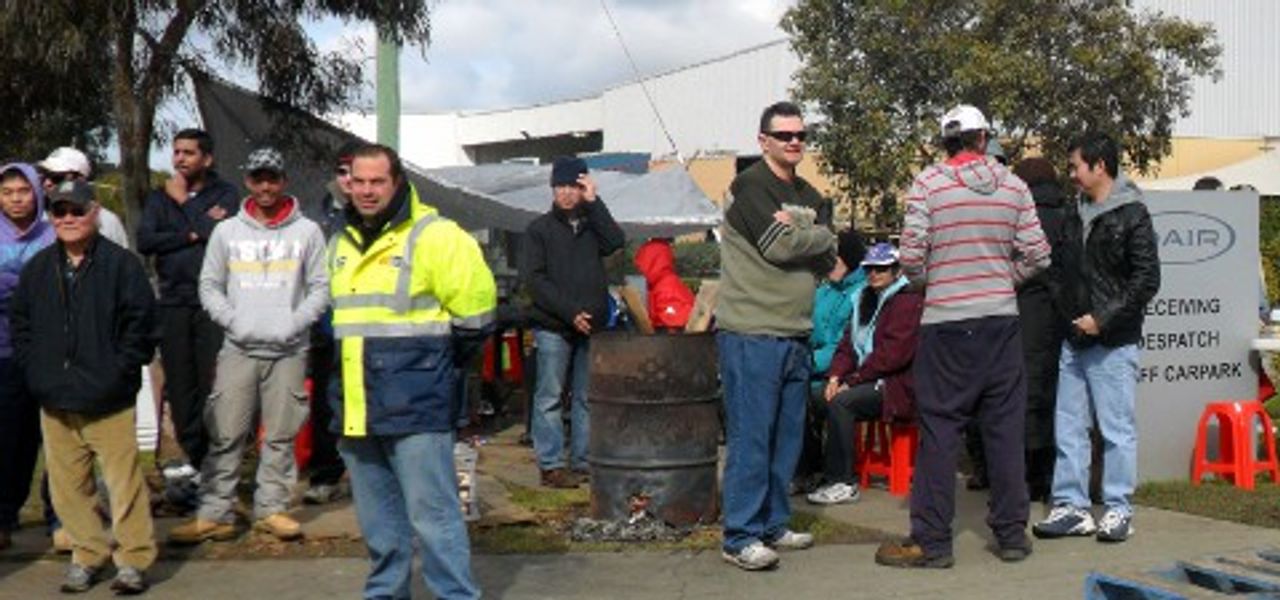Federal Workplace Relations Minister Bill Shorten personally brokered an agreement yesterday between the trade unions and management from DAIR Industries, a car components plant in Melbourne, to shut down a strike that began last Wednesday. The Labor government’s intervention underscores the central role it is playing in orchestrating the pro-business restructuring of the car industry in Australia.
About 140 workers at DAIR, covered by the Australian Workers Union and the Australian Manufacturing Workers’ Union (AMWU), went on strike over the terms of a new enterprise bargaining agreement (EBA). The plant manufactures various metal parts for Toyota, Ford and Holden, including rear bumper assemblies, foot brakes, and clutch mechanisms.
 DAIR workers picketline
DAIR workers picketlineThe new EBA involves a small annual wage rise of between 3 and 3.5 percent. The agreement also equalises the previously varying wage rates received by different workers doing the same work. The Dandenong plant was developed through a series of takeovers and closures in the components sector over the past decade. Workers brought in from other plants were kept on their previous enterprise agreements, producing significant disparities. For example, machine operators doing the same job had hourly rates of pay varying from $16.70 to $21.50, depending on which factory they came from.
The issue that triggered the strike was DAIR management’s insistence that a cap be placed on redundancy payouts. Most DAIR workers previously had uncapped redundancy entitlements, based on how long they had worked at the plant, but other workers brought in from other plants could be sacked and paid the equivalent of no more than 40 or 52 weeks’ wages.
Shorten intervened after Ford and Holden declared that the DAIR strike could force them to shut down production due to parts shortages. He convened a “conciliation” session at the Fair Work Australia tribunal yesterday morning, after which the unions called a meeting of the workers and pushed through a vote to return to work. The agreement delivered DAIR management’s central demand—a cap on redundancy payouts, of 104 weeks.
 Phirom
PhiromWorld Socialist Web Site reporters spoke with several DAIR workers on Saturday. They stressed their fears of being laid off, like so many of their counterparts in the car industry in recent years, and expressed their determination not to make any concessions on redundancy entitlements. “With the car industry we don’t know what’s going to happen,” Phirom said. “If they plan to go overseas we may lose everything.”
“All the benefits we’ve deserved for the last 15 to 20 years they now want to take away by freezing our redundancy pay,” Hong explained. “It’s all about their profit. I agree that the company has to earn back something, but not by taking things away from the people who help you earn it. You can’t take it away from the people who work their lives here. Between the banks and the companies, they should give a life to the people who work hard every single minute.”
 Hong
HongPierre Rault has worked as a maintenance technician at DAIR for eight years and is a delegate for the AMWU. “We have never had industrial action at the site before,” he explained. “We aren’t asking for more. We just want to keep entitlements we already have. Not just for us, it’s for future years and the next generation. We have a responsibility to take this stand. The main thing is we have to keep what we’ve had for the last 30 years—no capped pay-outs.”
The unions’ sell out agreement has now imposed capped payouts. The union bureaucracy has effectively given the green light for further restructuring measures at the expense of workers’ jobs. AMWU assistant secretary Leigh Diehm declared: “[The] cap of 104 weeks will cover off on the vast majority of redundancy entitlements over the course of the three years of this agreement.”
The unions consciously use workers’ legitimate concerns for their redundancy entitlements as a diversion and a substitute for any campaign to defend jobs. In the name of boosting the industry’s “international competiveness”, union bureaucrats work hand in hand with federal and state governments and the car companies to boost corporate profit rates by organising and enforcing plant closures, job cuts, and worse wages and conditions.
The global auto industry has undergone a vast restructuring since the 2008 financial crash. The Obama administration’s takeover of General Motors and Chrysler in 2009, and its slashing of workers’ wages by 50 percent and more, triggered a worldwide drive to gut the pay and conditions of car workers.
In Australia in recent months there has been a wave of layoffs. Toyota summarily dismissed 350 workers earlier this year, Ford announced 440 job cuts, Holden another 100, parts maker CMI Industrial collapsed with the loss of 120 jobs, and the struggling APV parts plant is to be closed later this month, after being placed in receivership in April, with the loss of 160 jobs.
Component companies are in an enormous crisis, hit by the slowdown in car production in Australia and by the three producers’ demands for lower input costs. In response, the Labor government is urging more sweeping restructuring measures. Last week Greg Combet, the federal minister for industry and innovation, announced a joint subsidy package with the Victorian and South Australian state governments of $35 million which will target, among other things, “business support to improve efficiency and productivity.” The additional money forms part of the government’s “New Car Plan”, which is centrally aimed at facilitating layoffs and plant closures.
This tripartite plan drawn up by government, companies, and trade unions depends on the continued suppression of resistance by car workers. Bill Shorten’s response to the DAIR strike—notwithstanding the limited nature of the workers’ demands—points to the Labor government’s extreme sensitivity about any auto industry workers taking industrial action in defence of their interests.
However, a genuine struggle in defence of jobs, wages, and conditions is only possible on the basis of car workers breaking from the unions, developing new forms of organisation in the factories, and turning out to other sections of the working class confronting similar attacks. Above all, what is required is a political fight against the Labor government which has to be based on a socialist and internationalist perspective.
Subscribe to the IWA-RFC Newsletter
Get email updates on workers’ struggles and a global perspective from the International Workers Alliance of Rank-and-File Committees.
